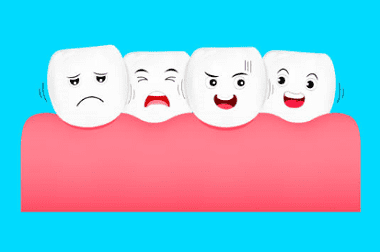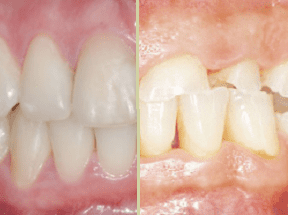Dentistry >>>> Pathological abrasion of teeth - prevention and treatment
Pathological abrasion of teeth - prevention and treatment.

Teeth wear is a natural physiological state in which over time (gradually) wear of the surfaces of the teeth (cutting and chewing) occurs as a result of friction of teeth - antagonists against each other when chewing solid food elements. The rate of physiological abrasion of teeth depends on many factors: the degree of hardness of enamel and dentin, regular eating of hard, hard-to-chew food components, bad habits associated with gnawing bones, nuts, seeds, removing corks from bottles with teeth and other traumatic factors. The structure of enamel and dentine is also weakened by sudden temperature changes when too cold and too hot elements alternate (for example, if you drink ice water or eat ice cream after a hot soup, and vice versa).
But there is also a pathological condition when there is an accelerated wear of the hard tissues of the tooth, which is called "pathological abrasion of teeth". In this condition, excessive wear of the teeth can occur within the enamel, within the dentin (to the upper part of the tooth cavity), or more intense abrasion, in which the coronal part of the tooth is erased almost completely. As a rule, the chewing surfaces of the teeth (occlusal) are erased to a greater extent, but with certain relationships of the dentition (with a direct bite, cross bite), the cutting edges of the teeth are exposed to excessive abrasion, and it is also possible to erase the teeth in the vertical direction (frontal, buccal and lingual surfaces teeth).
Pathological abrasion of teeth has many prerequisites:
- hereditary weak structures of enamel and dentin,
- demineralization of teeth,
- bad habits (constant chewing of chewing gum, tobacco, etc.),
- rough food,
- concomitant diseases: bruxism, epilepsy, pulp necrosis, impaired function of the parathyroid glands, adrenal cortex, impaired absorption of nutrients in the intestine, impaired metabolic processes (hypocalcemia, hypophosphatemia),
- medicines containing acids,
- hazardous industries associated with the dustiness of the atmosphere with abrasive dust that settles on the teeth at the time of inhalation,
- prosthetics of teeth - antagonists with crowns made of materials exceeding the degree of hardness of tooth enamel and causing grinding of the contacting surfaces during friction.

Pathological abrasion of the teeth entails a drop in the height of the bite, which changes not only the function of the dentition and causes distortion in the proportions of the face, but also creates deformation changes in the temporomandibular joint and sometimes complicates the chewing process, causes headaches and many painful conditions in the adjacent anatomical structures of the mandibular joint. With pathological abrasion, the sensitivity of the teeth increases, the pulp remains unprotected and can die (necrotize), which will disrupt the metabolic processes in the tooth, depriving it of the opportunity to receive useful components.
Treatment of pathological abrasion of teeth is aimed at replenishing the mineral elements in the body that maintain the hardness of the teeth, as well as prosthetics of erased teeth by making metal crowns (including restorative ones), which protect the remaining coronal parts of the teeth from further decay, as well as help restore the height of the bite. With bruxism, mouthguards are installed at night, opening the dentition and preventing excessive stress on the dental surfaces.
There is the prevention of pathological abrasion of the teeth, which consists in changing the nature of the food consumed (coarse fiber, excessively hard) to ground, soft and not requiring special efforts for grinding. Much attention is paid to the replenishment of microelement compounds (calcium, phosphorus) and protein compounds by the body .

Read

Read



























